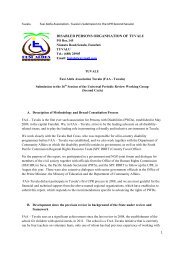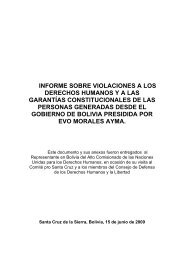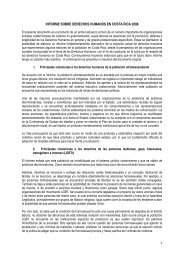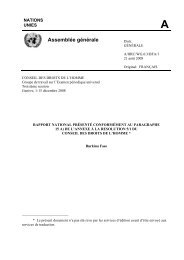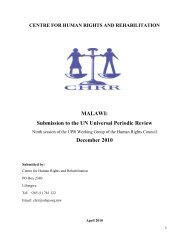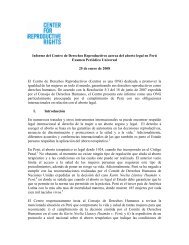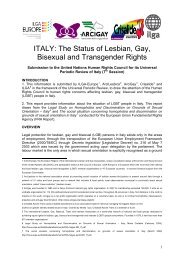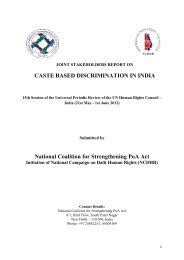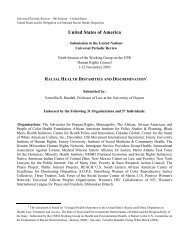Prison Needle Exchange: Lessons from a Comprehensive Review ...
Prison Needle Exchange: Lessons from a Comprehensive Review ...
Prison Needle Exchange: Lessons from a Comprehensive Review ...
You also want an ePaper? Increase the reach of your titles
YUMPU automatically turns print PDFs into web optimized ePapers that Google loves.
to the United States. Thus, the situation described by the National Commission on AIDS is<br />
evident in numerous countries.<br />
Western Europe, Australia, and the United States<br />
High rates of HIV infection among incarcerated populations have been reported in numerous<br />
countries. In Spain, it is estimated that the overall rate of HIV infection among prisoners<br />
is 16.6%, with a figure as high as 38% among some prison populations. 4 In Italy, a rate<br />
of 17% has been reported. 5 High HIV infection rates among prisoners have also been reported<br />
in France (13%; testing of 500 consecutive entries), Switzerland (11%; cross-sectional<br />
study in five prisons in the Canton of Berne), and the Netherlands (11%; screening of a sample<br />
of prisoners in Amsterdam). 6 In contrast, some European countries, including Belgium,<br />
Finland, Iceland, Ireland, and some Länder in Germany, report lower levels of HIV prevalence.<br />
7 Relatively low rates of HIV prevalence have also been reported <strong>from</strong> Australia. 8<br />
A recent US study found that an estimated 25% of all HIV-infected citizens pass through<br />
a correctional facility in the US each year. 9 In the US, the geographic distribution of cases of<br />
HIV infection and AIDS is uneven. Many systems have reported HIV prevalence rates under<br />
1%, while others have rates that approach or exceed 8%. 10<br />
Central and Eastern Europe and the former Soviet Union<br />
In the countries of Central and Eastern Europe and the former Soviet Union, high rates of<br />
HIV infection among people who inject drugs and among prisoners is a growing concern. In<br />
the Russian Federation, by late 2002 the registered number of peo-<br />
ple living with HIV/AIDS in the penal system exceeded 36,000,<br />
representing approximately 20% of known HIV cases. 11 In Ukraine,<br />
where 69% of HIV infection is linked to injection drug use, 12 it is<br />
estimated that 7% of the prison population is HIV-positive. 13 In<br />
Latvia it is estimated that prisoners comprise a third of the country’s<br />
HIV-positive population, and that a fourth of all HIV-positive persons<br />
in Latvia were infected while in prison. 14 In Lithuania, in May<br />
2002 the number of new HIV-positive test results among prisoners<br />
found in a two-week period equalled all the cases of HIV identified in the entire country during<br />
all of the previous years combined. 15 In total, 284 prisoners (15% of the total Lithuanian<br />
prison population) were diagnosed HIV-positive between May and August 2002. 16<br />
In the Russian Federation, the<br />
registered number of people<br />
living with HIV/AIDS in the<br />
penal system exceeds 36,000.<br />
Canada<br />
Estimates of HIV prevalence in Canadian federal and provincial prisons range <strong>from</strong> 2% to<br />
8% 17 , while studies of HIV prevalence in individual prisons report rates of between 1% and<br />
11.94% . 18 Even adopting a conservative approach, these estimates place the HIV prevalence<br />
rate in prisons at 10 times the prevalence rate in the general Canadian population. 19<br />
According to preliminary data, 2.01% of all prisoners in Canadian federal prisons were<br />
known to be HIV-positive, with higher rates among women (3.71%). 20 Among the five<br />
Correctional Service Canada regions, the rate of reported HIV cases was highest in the<br />
Québec region (2.7%) and lowest in the Ontario region (0.7%). 21 A number of HIV prevalence<br />
studies have been conducted in federal and provincial prisons, including:<br />
• The first HIV prevalence and risk behaviour study in a Canadian prison was undertaken<br />
in a medium-security prison for women in Montréal. 22 Of the 321 participants, 23<br />
(7.2%) were HIV-positive and 160 (49.8%) reported injection drug use. Non-sterile<br />
6 <strong>Prison</strong> <strong>Needle</strong> <strong>Exchange</strong>: <strong>Lessons</strong> <strong>from</strong> a <strong>Comprehensive</strong> <strong>Review</strong> of International Evidence and Experience



